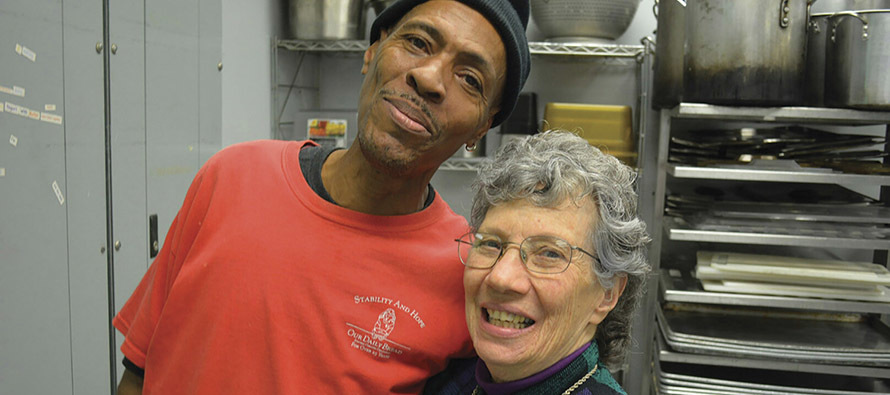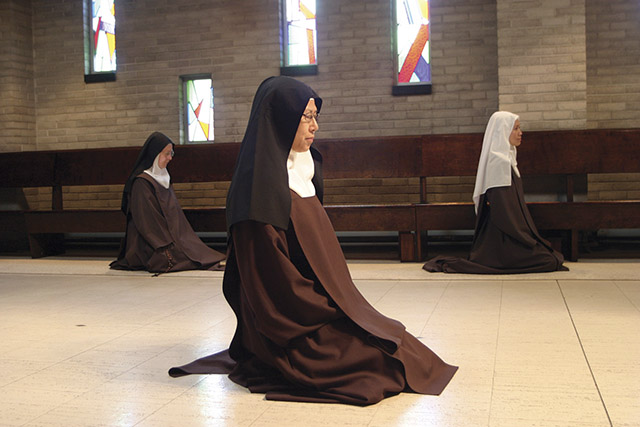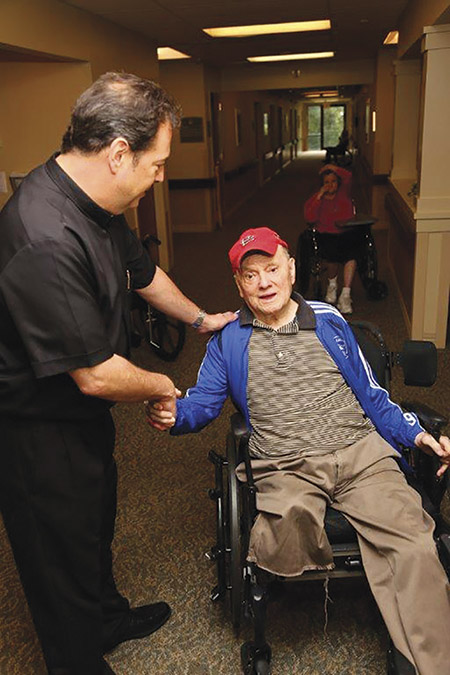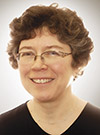What is charism?

Sister Therese DelGenio, S.N.D.deN. expresses her community’s charism through her work at Cincinnati’s Our Daily Bread, an organization that calls itself a “ministry of hospitality.” (Photo: Annie Worobetz. Courtesy of Sisters of Notre Dame de Namur.)
My friend Sheryl is a Cistercian. She set off with some other nuns from the United States and Europe to refound a monastery on an island in the middle of Norway, where Cistercians had lived for three centuries during the Middle Ages. She speaks Norwegian now.
Sheryl and the other sisters sing the Liturgy of the Hours together in their chapel seven times each day. They work not at outside jobs but inside the monastery, making herbal soaps and skin cream to support themselves. The Cistercian day is a balance of prayer (both private and choral), work, and spiritual reading. The sisters spend much of the day in silence.
Another friend of mine, Thérèse, a Sister of Notre Dame de Namur, opened a homeless shelter with one of her fellow sisters on the South Side of Chicago, where my family and I have volunteered for many years. We go once a month, but Thérèse would go every day. Thérèse tells me that her community lives to recognize and reflect the goodness of God everywhere.
Today she works at a day shelter for homeless people in Cincinnati. One morning in January, while guests waited for breakfast and Thérèse was in her tiny office with the door closed writing up reports, she heard commotion and then gunshots out in the shelter. She crawled under her desk and called 911. When police arrived, Thérèse emerged to find a dead man sprawled 10 feet from her office door. A man had come to shoot a woman who had jilted him and the man she had taken up with. The shooter was arrested, and the woman was taken to the hospital in critical condition.
Her reaction to what followed this tragic, terrifying episode shows how she’s a Sister of Notre Dame de Namur down to her bones. “People were so good to us,” she says, praising those who brought hot meals and sandwiches for the shelter guests, who were moved into a heated bus without their belongings while the crime scene investigation went on and on. She applauded others who later sent cards, flowers, and other gifts to the staff and guests. The police victims’ assistance unit spent hours with those who’d been present, helping them begin to recover from the experience. One agency volunteered its architect to help construct a space where the shelter’s 400 guests could check their belongings to improve security, and someone else paid for 400 bins. “Isn’t this all goodness personified?” Thérèse says. “We look for it even though things might be as black as can be.”

Although Sheryl and Thérèse are both women religious, they lead very different lives. Why? It all comes down to charism. This 10-dollar word, which you don’t hear much in ordinary conversation, is the gift at the heart of all religious communities. Their charism is why they were founded and it is what keeps them going through the decades and even centuries.
Charism is—what again?
• A charism is a gift that comes from the Holy Spirit. Its purpose? To serve others, and especially to build up and renew the Body of Christ, the church.
• When religious communities use the word charism, they mean the particular gift of the Spirit that inspired their founder—a man or woman of bold vision, who gathered other people to help turn that vision into action.
• The story of a community’s founder will reveal a charism in action. Often these people did not even envision founding a religious community; they simply felt a passion to do something to meet a specific need of their time. This burning desire came from the Spirit. Others wanted to join them, and out of this grew the community.
• Charisms enable you to tell religious communities apart from one another. The Holy Spirit calls these groups of men and women to different things and gives them different gifts. We need all these many gifts to build up the Body of Christ.
• The charism guides the community as it makes decisions about its mission and its future. This is true whether the founder lived 50 or 1,500 years ago.
• You have a charism, too. Sister Mary Pellegrino, C.S.J. writes in America, “[O]ur charisms are not confined to vowed, religious life. They are found and flourish among single and married persons, and clergy, as well.” Saint Paul says that each of us, by virtue of our Baptism, receives gifts of the Spirit for the good of us all.
Reaction to needs
You can trace the development of a community’s charism back to a specific historical moment. That’s because the founder read the signs of the times, and with a push from the Holy Spirit moved into action to do what needed to be done. The Alexian Brothers, for example, trace their origins to 12th-century Europe when small groups banded together to tend the sick and bury the dead—revolutionary actions at the time. During the Black Death in the 14th century, which killed almost a third of Europe’s population, they stayed with the sick and dying when others fled. These lay brothers were not even recognized as a religious community by the pope until 1472.
Or consider the Sisters of Mercy. In 1827, Dublin’s Catherine McAuley used a sizable inheritance to open a house that would serve as a school for poor girls and a shelter for homeless girls and women. As other women volunteered to help, McAuley envisioned a lay corps of Catholic social workers, not a religious order—especially since sisters at the time were confined to their convents. Eventually the women realized that for the sake of stability they’d be better off as a religious community, though not stuck in a convent. They called themselves the Sisters of Mercy, as they sought to make tangible the merciful love of God to all, especially the poor. Dubliners, however, often called them the “walking nuns” because they spent so much time out in the community among the poor.
Evolving response
Religious communities continually reflect on their founding charism to figure out how best to put their heritage into action in today’s world. The Alexian Brothers in Chicago, for example, in the 1980s began taking people dying of AIDS into their personal residences, opening a permanent facility for them in 1989. Because family and friends often abandoned those suffering from this dangerous new disease, who bore a great moral stigma as well, the brothers stepped in to care for them, just as they had for the afflicted during Europe’s Black Death six centuries before.

The Order of Mercy, or Mercedarians, founded in 1218 during the Crusades to ransom Christians captured by Muslims, is now working with the Chaldean Archbishop of Erbil in Iraq, who has asked them for prayers and economic support to help thousands of Christian families fleeing persecution by ISIS.
The Sisters of Notre Dame de Namur, whose founder, Saint Julie Billiart, advised her sisters to “educate for life,” still serve in Catholic schools, but for decades now have also been interpreting their charism more broadly. For example, my friend Sister Thérèse “educates for life” as a social worker at the Cincinnati day shelter where she works with people trying to recover from substance abuse, trauma, domestic abuse, and chronic poverty, among other challenges.
What’s my charism?
If you’re considering joining a religious community, you’re likely asking yourself if you’re drawn to a particular charism and what gifts you have to live it. It can take time trying a few out to figure it out.
Father Brian Walker worked in the missions as a priest before realizing what he really wanted to do was preach, so he joined the Dominicans, the Order of Preachers. “I wanted to preach in season and out, and now that’s what my whole life is about,” he says. “I preach from personal experience and from the scripture and how it’s spoken to me.” One of Walker’s favorite preaching themes is “To praise, to bless, to preach.”
“All of us are called to praise and recognize God in all creation, to bless one another and what has been given us, and also to preach about the goodness of all of that,” he says. “Not everybody can preach from the pulpit, but we all preach by what we say and do, how we treat one another, and how we interact with one another. What does our interaction leave in our wake? What does it say about us when we’re gone?”
Sister Sheryl, the Cistercian nun in Norway, writes that the opportunity to sing the Liturgy of the Hours seven times a day was the main reason she joined the Cistercians. Her daily experience has changed over time: “When I was a novice, the silence was very strict. We had to learn a sign language to avoid speaking in the seven most important rooms in the monastery. Now we use common sense and charity to discern when it is simplest to have a quiet conversation. Our constitutions claim that only with a personal love for Jesus can one persevere in a life that is ‘ordinary, obscure, and laborious.’ If the mystery and intensity of that appeals to you, come and see!”
It’s women and men of bold vision and commitment who live out the charisms of Catholic religious orders today. Perhaps you’re one of them.
Related article: VocationNetwork.org, “Vocation terms defined.”
Tags
Related
- Ten great things about being Catholic
- FOR PARISHES & PREACHERS: Sample homilies that encourage vocation discernment
- Six myths about becoming a nun
- Consecrated life: Words of wisdom
- Consecrated life through the ages (Religious Life Timeline)
- FOR BULLETIN EDITORS & DISCERNERS: Reflections on consecrated life
- PRAYER CARD: Pope Francis Prayer for Vocations
- Major traditions in religious life: What does it mean to be a Carmelite?
- Resources for older discerners or those with physical and developmental differences
- The essential facts about secular institutes Read More
Most Viewed
- Find your spirituality type quiz
- Questions and answers about religious vocations
- Celibacy quiz: Could I be a nun? Could I be a brother? Could I be a priest?
- Resources for older discerners or those with physical and developmental differences
- About Vocation Network and VISION Guide


